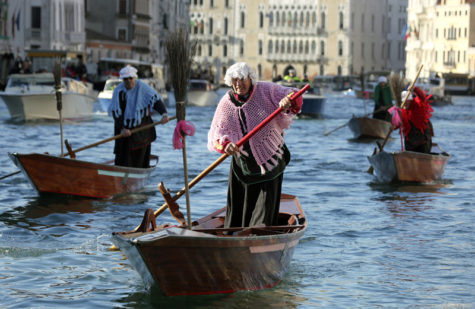In Italian folklore, Befana is an old woman who delivers gifts to children throughout Italy on Epiphany Eve (the night of January 5) in a similar way to St Nicholas or Santa Claus.
In popular folklore Befana visits all the children of Italy on the eve of the Feast of the Epiphany to fill their socks with candy and presents if they are good, or a lump of coal or dark candy if they are bad. In many poorer parts of Italy and in particular rural Sicily, a stick in a stocking was placed instead of coal. Being a good housekeeper, many say she will sweep the floor before she leaves. To some the sweeping meant the sweeping away of the problems of the year. The child’s family typically leaves a small glass of wine and a plate with a few morsels of food, often regional or local, for the Befana.
Befana is invoked in many Italian spells, especially those for good fortune. She brings sweets for children but may be persuaded to bring the sweetness of life to adults as well.
- On Epiphany Eve, write her a note expressing your desires.
- Place it beneath a red witch-shaped candle and burn.
- Accompany with offerings.
She is usually portrayed as a hag riding a broomstick through the air wearing a black shawl and is covered in soot because she enters the children’s houses through the chimney. She is often smiling and carries a bag or hamper filled with candy, gifts, or both. Popular tradition tells that if one sees La Befana one will receive a thump from her broomstick, as she doesn’t wish to be seen. This aspect of the tradition may be designed to keep children in their beds.
She is also referred to as the Christmas Witch.
The Befana today:
The Befana is celebrated throughout all of Italy, and has become a national icon. In the regions of the Marches, Umbria and Latium, her figure is associated with the Papal States, where the Epiphany held the most importance. Urbania is thought to be her official home. Every year there is a big festival held to celebrate the holiday. About 30,000-50,000 people attend the festivities. Hundreds of Befana’s are present, swinging from the main tower. They juggle, dance and greet all the children. Traditionally, all Italian children may expect to find a lump of “coal” in their stockings (actually rock candy made black with caramel coloring), as every child has been at least occasionally bad during the year.
Places associated with the Befana tradition:
Piazza Navona in central Rome is the site of a popular market each year between Christmas and the Epiphany, where toys, sugar charcoal and other candies are on sale. The feast of the Befana in Rome was immortalized in four famous sonnets in the Roman dialect by the 19th century Roman poet Giuseppe Gioacchino Belli. In Ottorino Respighi’s 1928 Feste Romane (“Roman Festivals”), the fourth movement, titled La Befana, is an orchestral portrayal of this Piazza Navona festival. Romans believe that at the midnight January 6 the Befana shows herself from a window of Piazza Navona, and they always go there to watch her (it’s a joke everybody tells while going to the feast to buy candies, toys and sweets).
The town of Urbania in the Province of Pesaro e Urbino within the Marches, where the national Befana festival is held each year, usually between January 2 and 6. A “house of the Befana” is scheduled to be built and the post office has a mailbox reserved for letters addressed to the Befana, mirroring what happens with Santa Claus in Rovaniemi.
In Fornovo di Taro a little town by Parma the national meeting “Raduno Nazionale delle Befane e dei Befani” is held the 5th and 6 January.
In other parts of the world where a vibrant Italian community exists, traditions involving Befana may be observed and shared or celebrated with the wider community.
In Toronto, Canada, a Befana Choir shows up on Winter Solstice each December to sing in the Kensington Market Festival of Lights parade. Women, men, and children dressed in La Befana costume and nose sing love songs to serenade the sun to beckon its return. The singing hags gather in the street to give candy to children, to cackle and screech to accordion music, and to sing in every key imaginable as delighted parade participants join in the cacophony. Sometimes, the Befanas dance with parade goers and dust down the willing as parade goers walk by.
Poems and songs:
There are poems about Befana, which are known in slightly different versions throughout Italy. Here is one of the versions:
La Befana vien di notte
Con le scarpe tutte rotte
Col vestito alla romana
Viva, Viva La Befana!
The English translation is:
The Befana comes by night
With her shoes all tattered and torn
She comes dressed in the Roman way
Long live the Befana!
Another version is given in a poem by Giovanni Pascoli:
Viene, viene la Befana
Vien dai monti a notte fonda
Come è stanca! la circonda
Neve e gelo e tramontana!
Viene, viene la Befana
The English translation is:
Here comes, here comes the Befana
She comes from the mountains in the deep of the night
Look how tired she is! All wrapped up
In snow and frost and the north wind!
Here comes, here comes the Befana!
Source: Wikipedia
Krazelna: Day of Hekate
Krazelna: Day of Hekate
Krazelna: Day of Hekate
Rachel V Perry: Emancipation Day
Rachel: The Nemesia





Leave a Reply